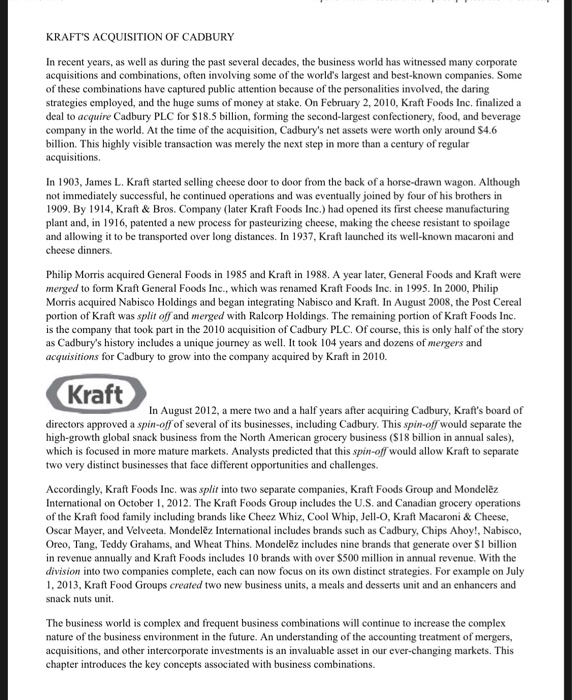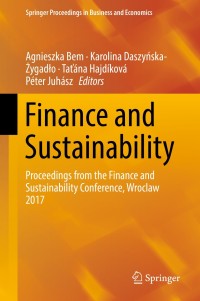- What roles do emerging versus mature markets play in Krafts decisions to acquire and subsequently divest?
- Analysts predicted the 2012 spin-off. What do you forecast as a next step for this conglomerate and what types of accounting challenges could we expect Kraft to face if your prediction becomes a reality?
KRAFTS ACQUISITION OF CADBURY In recent years, as well as during the past several decades, the business world has witnessed many corporate acquisitions and combinations, often involving some of the world's largest and best-known companies. Some of these combinations have captured public attention because of the personalities involved, the daring strategies employed, and the huge sums of money at stake. On February 2, 2010, Kraft Foods Inc. finalized a deal to acquire Cadbury PLC for S18.5 billion, forming the second-largest confectionery, food, and beverage company in the world. At the time of the acquisition, Cadbury's net assets were worth only around $4.6 billion. This highly visible transaction was merely the next step in more than a century of regular acquisitions In 1903, James L. Kraft started selling cheese door to door from the back of a horse-drawn wagon. Although not immediately successful, he continued operations and was eventually joined by four of his brothers in 1909. By 1914, Kraft & Bros. Company (later Kraft Foods Inc.) had opened its first cheese manufacturing plant and, in 1916, patented a new process for pasteurizing cheese, making the cheese resistant to spoilage and allowing it to be transported over long distances. In 1937, Kraft launched its well-known macaroni and cheese dinners. Philip Morris acquired General Foods in 1985 and Kraft in 1988. A year later, General Foods and Kraft were merged to form Kraft General Foods Inc., which was renamed Kraft Foods Inc. in 1995. In 2000, Philip Morris acquired Nabisco Holdings and began integrating Nabisco and Kraft. In August 2008, the Post Cereal portion of Kraft was split off and merged with Ralcorp Holdings. The remaining portion of Kraft Foods Inc. is the company that took part in the 2010 acquisition of Cadbury PLC. Of course, this is only half of the story as Cadbury's history includes a unique journey as well. It took 104 years and dozens of mergers and acquisitions for Cadbury to grow into the company acquired by Kraft in 2010. Kraft In August 2012, a mere two and a half years after acquiring Cadbury, Kraft's board of directors approved a spin-off of several of its businesses, including Cadbury. This spin-off would separate the high-growth global snack business from the North American grocery business (S18 billion in annual sales) which is focused in more mature markets. Analysts predicted that this spin-off would allow Kraft to separate two very distinct businesses that face different opportunities and challenges. Accordingly, Kraft Foods Inc. was split into two separate companies, Kraft Foods Group and Mondelez International on October 1, 2012. The Kraft Foods Group includes the U.S. and Canadian grocery operations of the Kraft food family including brands like Cheez Whiz, Cool Whip, Jell-O, Kraft Macaroni & Cheese, Oscar Mayer, and Velveeta. Mondelez International includes brands such as Cadbury, Chips Ahoy!, Nabisco, Oreo, Tang. Teddy Grahams, and Wheat Thins. Mondelez includes nine brands that generate over SI billion in revenue annually and Kraft Foods includes 10 brands with over $500 million in annual revenue. With the division into two companies complete, each can now focus on its own distinct strategies. For example on July 1, 2013, Kraft Food Groups created two new business units, a meals and desserts unit and an enhancers and snack nuts unit. The business world is complex and frequent business combinations will continue to increase the complex nature of the business environment in the future. An understanding of the accounting treatment of mergers, acquisitions, and other intercorporate investments is an invaluable asset in our ever-changing markets. This chapter introduces the key concepts associated with business combinations. KRAFTS ACQUISITION OF CADBURY In recent years, as well as during the past several decades, the business world has witnessed many corporate acquisitions and combinations, often involving some of the world's largest and best-known companies. Some of these combinations have captured public attention because of the personalities involved, the daring strategies employed, and the huge sums of money at stake. On February 2, 2010, Kraft Foods Inc. finalized a deal to acquire Cadbury PLC for S18.5 billion, forming the second-largest confectionery, food, and beverage company in the world. At the time of the acquisition, Cadbury's net assets were worth only around $4.6 billion. This highly visible transaction was merely the next step in more than a century of regular acquisitions In 1903, James L. Kraft started selling cheese door to door from the back of a horse-drawn wagon. Although not immediately successful, he continued operations and was eventually joined by four of his brothers in 1909. By 1914, Kraft & Bros. Company (later Kraft Foods Inc.) had opened its first cheese manufacturing plant and, in 1916, patented a new process for pasteurizing cheese, making the cheese resistant to spoilage and allowing it to be transported over long distances. In 1937, Kraft launched its well-known macaroni and cheese dinners. Philip Morris acquired General Foods in 1985 and Kraft in 1988. A year later, General Foods and Kraft were merged to form Kraft General Foods Inc., which was renamed Kraft Foods Inc. in 1995. In 2000, Philip Morris acquired Nabisco Holdings and began integrating Nabisco and Kraft. In August 2008, the Post Cereal portion of Kraft was split off and merged with Ralcorp Holdings. The remaining portion of Kraft Foods Inc. is the company that took part in the 2010 acquisition of Cadbury PLC. Of course, this is only half of the story as Cadbury's history includes a unique journey as well. It took 104 years and dozens of mergers and acquisitions for Cadbury to grow into the company acquired by Kraft in 2010. Kraft In August 2012, a mere two and a half years after acquiring Cadbury, Kraft's board of directors approved a spin-off of several of its businesses, including Cadbury. This spin-off would separate the high-growth global snack business from the North American grocery business (S18 billion in annual sales) which is focused in more mature markets. Analysts predicted that this spin-off would allow Kraft to separate two very distinct businesses that face different opportunities and challenges. Accordingly, Kraft Foods Inc. was split into two separate companies, Kraft Foods Group and Mondelez International on October 1, 2012. The Kraft Foods Group includes the U.S. and Canadian grocery operations of the Kraft food family including brands like Cheez Whiz, Cool Whip, Jell-O, Kraft Macaroni & Cheese, Oscar Mayer, and Velveeta. Mondelez International includes brands such as Cadbury, Chips Ahoy!, Nabisco, Oreo, Tang. Teddy Grahams, and Wheat Thins. Mondelez includes nine brands that generate over SI billion in revenue annually and Kraft Foods includes 10 brands with over $500 million in annual revenue. With the division into two companies complete, each can now focus on its own distinct strategies. For example on July 1, 2013, Kraft Food Groups created two new business units, a meals and desserts unit and an enhancers and snack nuts unit. The business world is complex and frequent business combinations will continue to increase the complex nature of the business environment in the future. An understanding of the accounting treatment of mergers, acquisitions, and other intercorporate investments is an invaluable asset in our ever-changing markets. This chapter introduces the key concepts associated with business combinations







